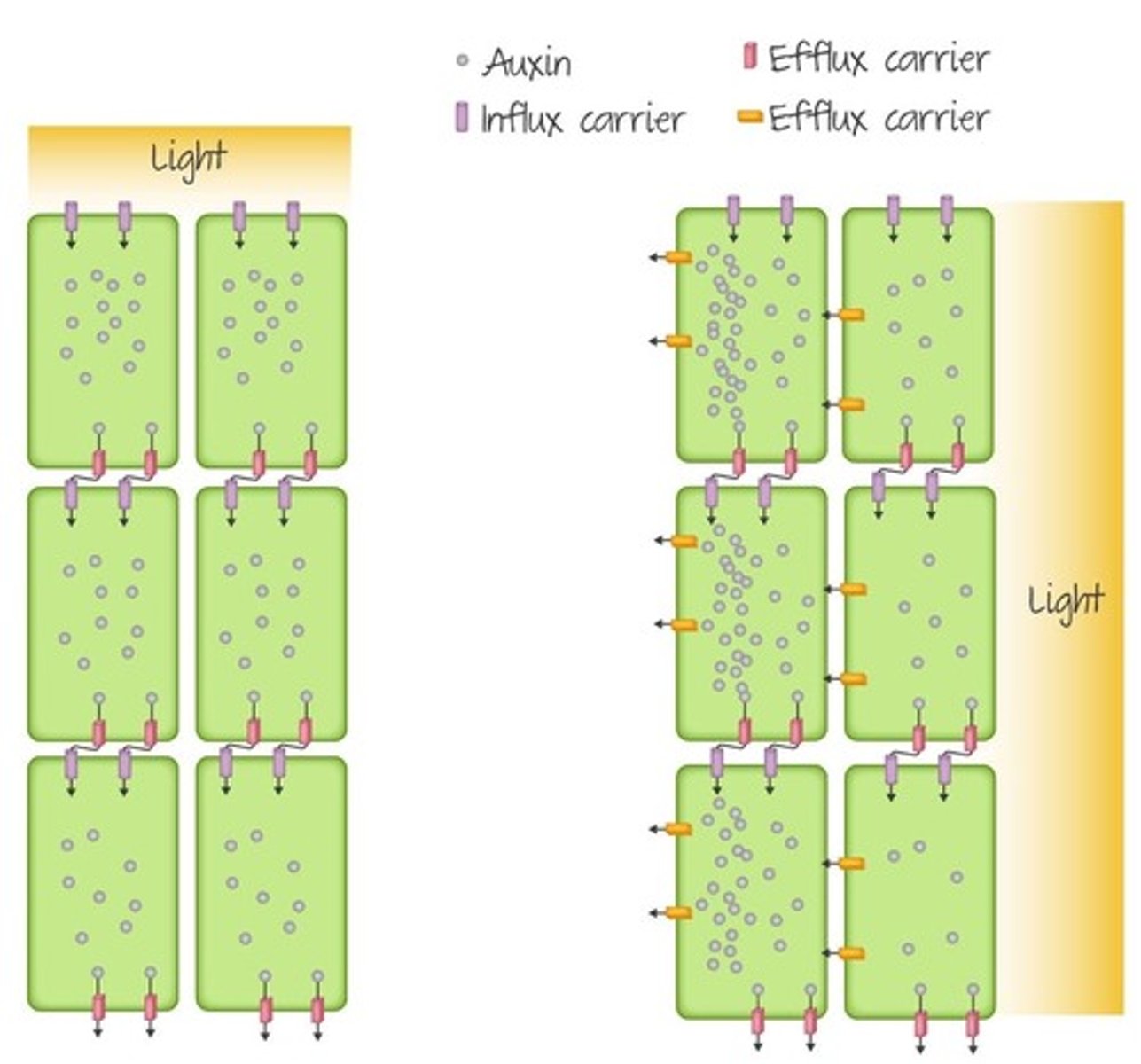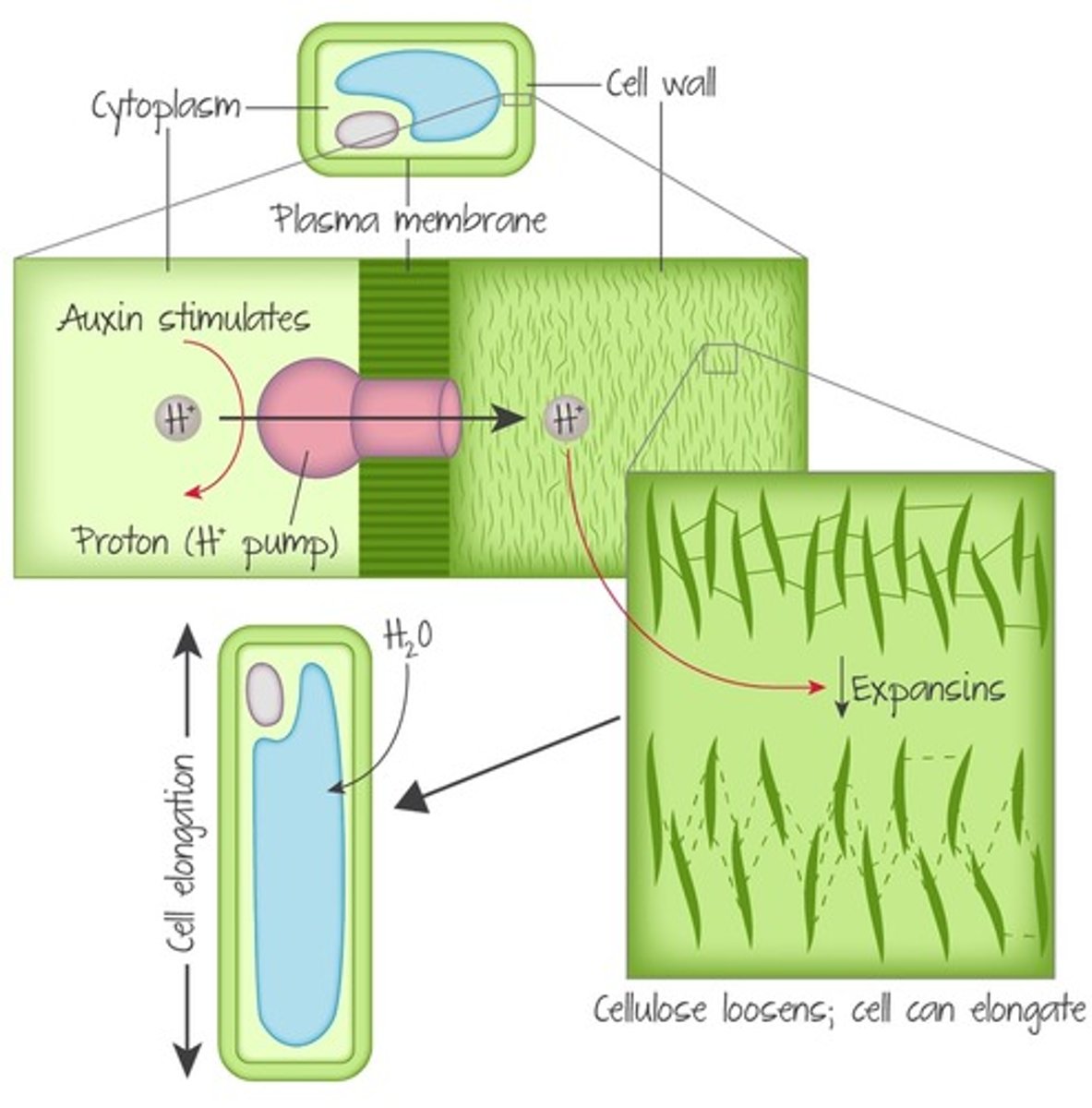Topic 9: Cell biology - Growth in plants (Auxin and cell elongation)
1/12
There's no tags or description
Looks like no tags are added yet.
Name | Mastery | Learn | Test | Matching | Spaced |
|---|
No study sessions yet.
13 Terms
What does auxin do?
The plant hormone auxin has a strong influence on cell elongation.
Where is auxin produced and where does it act?
Auxin is produced in the shoot apical meristem but acts on other target cells in the plant.
Since auxin acts on target cells other than those in the shoot apical meristem, how does it reach those target cells?
Much of the auxin is:
- Transported in the bulk flow of the phloem
- But also actively moved from cell to cell through several methods
How does a plant detect light intensity?
In the apical meristem, a group of proteins called phototropins are produced to detect light intensity.
What happens when light is equally bright on all sides of the shoot tip?
Auxin moves symmetrically downward, being pumped into and out of successive layers of cells through specialised protein pumps.
How are auxins able to move symmetrically downward when light is equally bright on all sides of the shoot tip?
Plant cells have auxin influx carriers in their apical (top) cell membranes and auxin efflux carriers in their bottom (basal) cell membranes.
This allows the cells to move auxin continually downward, pumped into the top of a cell and out of the bottom, then into the cell below, as seen in Figure 1 (left).
Figure 1: Auxin transport and distribution in overhead versus side lighting.

What does this symmetrical downward movement of auxin lead to?
This even distribution of auxin leads to:
- Even cell growth
- Vertical extension of the stem
Outline what happens when there is a difference in brightness of different sides of the shoot
1. Phototropins cause some types of auxin efflux carriers to increase on the internal lateral (side) membrane.
2. This causes transport of auxin to the shaded side of the plant and establishes a concentration gradient, as seen in Figure 1 (right).
3. The shaded side of the shoot experiences greater cell elongation, bending the stem toward the light.
Figure 1: Auxin transport and distribution in overhead versus side lighting.

What goes on once auxin has accumulated on the shaded side?
It triggers several changes in the cells. These changes allow multiple responses, including the cell elongation that leads to phototropic (and other tropic) responses.
Explain the changes that occurs within cells once auxin accumulates on the shaded side of a shoot tip
1. Auxin alters gene expression in several gene families. The expression of these genes is also linked to other factors in the cell, allowing auxin to trigger a wide variety of responses depending on the type of cell and environmental conditions.
- Auxin stimulates the transcription of genes that produce proton pumps
2. Auxin stimulates cell elongation in the stem.
- Auxin stimulates proton pumps that use ATP to move protons (hydrogen ions, H+) out of the cytoplasm and into the cell wall.
- A higher H+ concentration in the cell wall means the cell wall becomes more acidic (a decreased pH).
- The acidic pH breaks bonds between cellulose fibres in the cell wall directly by disrupting hydrogen bonding and indirectly by activating pH-dependent expansin proteins that sever cellulose connections.
- The reduced number of bonds between cellulose microfibrils makes the cell wall more flexible
- Cellulose fibres can slide apart as they are pushed by turgor pressure inside the cell, thus the cell elongates as the cell wall becomes softer and more flexible
Figure 2 summarises how auxin leads to cell elongation
Figure 2: Auxin stimulates cell elongation through proton pumps.

The cell-to-cell transport of auxin down the stem is achieved through:
1. Expansin proteins
2. Adhesion to cellulose microfibrils
3. Bulk flow in the phloem
4. Auxin influx and efflux carrier proteins
Auxin influx and efflux carrier proteins
Which of the following is not a step involved in cell elongation?
1. Expression of genes coding for proton pump proteins
2. Disruption of bonds between cellulose microfibrils
3. Loss of water from the cell by osmosis
4. Secretion of H+ ions into the cell wall
Loss of water from the cell by osmosis